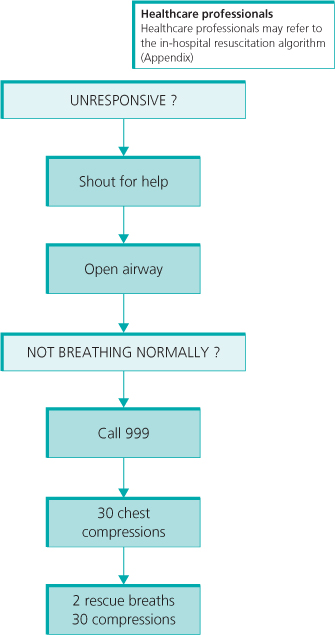Introduction
The term basic life support (BLS) is used to describe maintenance of a clear airway and support of breathing and the circulation in cases of cardiac arrest, without the use of equipment other than a simple airway device or protective shield. Cardiopulmonary resuscitation (CPR) is the combination of chest compression and rescue breathing, and forms the basis of modern BLS.
The chances of survival after cardiac arrest are increased when the event is witnessed and when a bystander institutes CPR prior to the arrival of the emergency services. When the heart arrests in ventricular fibrillation, the critical interval that determines outcome is the time from arrest until defibrillation, the chances of survival decreasing by between 7 and 10% for each minute of delay. Effective CPR reduces this decline by about 50%.
The best chance of a successful outcome for the patient is achieved if chest compressions are started as soon as cardiac arrest is diagnosed. Chest compressions should be given with minimal interruptions at the recommended rate and depth, and are accompanied by artificial ventilation according to the current guidelines (see Box 4.1 and Figure 4.1).
Figure 4.1 Adult basic life support. Reproduced with the kind permission of the Resuscitation Council (UK).

- Depth 5–6 cm
- Rate 100–120 min−1
- Release pressure fully between each compression
- Minimise interruptions in CPR
Diagnosing cardiac arrest
Although an absent carotid pulse in an unconscious patient is a sure sign of cardiac arrest, it has been shown that the accuracy of such a pulse check can be very poor, not only for laypeople. Unless the rescuer is trained, experienced, and confident in feeling for the carotid pulse, a diagnosis of cardiac arrest should be assumed if the patient is unresponsive and not breathing normally.
Agonal breathing
Particular care should be taken to recognise agonal breathing (irregular, often noisy, gasps) as a sign of cardiac arrest and not a sign of life. If agonal breathing is present, start CPR.
Circulatory support
A patient in cardiac arrest is unlikely to recover as a result of CPR alone, but rapid institution of resuscitation, particularly chest compression, can ‘buy time’ until a defibrillator and the emergency services arrive.
The correct place to compress the chest is in the centre of the lower half of the sternum. It is recommended that this location be taught in a simplified way, such as, ‘place the heel of your hand in the centre of the chest with the other hand on top’. This instruction should be accompanied by a demonstration of placing the hands on the lower half of the sternum on a manikin. Use of the inter-nipple line as a landmark is not reliable.
Firm pressure is needed to compress the chest of an adult by 5–6 cm. The rescuer’s arms should be kept straight with the elbows locked. About the same amount of time should be spent in the compressed phase as in the released phase, with complete release of pressure each time. The rate should be between 100–120 min−1 and compressions should be given in groups of 30, interspersed with 2 rescue breaths.
Ventilatory support
Establishing and maintaining an airway is the single most useful manoeuvre that the rescuer can perform. To open the airway, the patient’s head should be tilted backwards (without hyperextension of the neck) and the jaw lifted to pull the tongue forward off the posterior pharyngeal wall.
To give mouth-to-mouth ventilation the patient’s nose should be pinched closed. The rescuer should then take a breath, make a firm seal with his or her lips around the patient’s mouth, and breathe out, watching as the patient’s chest clearly rises as in normal breathing. This should take about a second, and it is important to avoid over-inflation as this will allow air to enter the oesophagus and stomach. Subsequent gastric distension causes not only vomiting but also passive regurgitation into the lungs, which often goes undetected. The expired air is then allowed out passively. As soon as the chest falls, another breath should be given, with 30 chest compressions being given after every 2 rescue breaths.
Risks to rescuer and patient
The main concern during resuscitation is for the patient, but it is equally important to ensure that no harm comes to the rescuer.
Before approaching a collapsed patient, the rescuer should rapidly assess any personal danger as well as any to the patient from hazards such as falling masonry, gas, electricity, fire, or traffic.
Although there may be fears about catching HIV (human immunodeficiency virus), no case has been recorded due to mouth-to mouth-resuscitation. Despite the presence of the virus in saliva, it does not seem that transmission occurs via this route in the absence of blood-to-blood contact. There have been reports of the transmission of other infections, such as tuberculosis (TB) and severe acute respiratory distress syndrome (SARS), but these have been very rare. Nevertheless, those who may be called upon to administer resuscitation should be allowed to use some form of barrier device, preferably a ventilation mask (for mouth-to-mask ventilation) or a filter device placed over the mouth and nose.
Adult basic life support sequence
Stay updated, free articles. Join our Telegram channel

Full access? Get Clinical Tree








